![]()
![]()
![]()
Use LEFT and RIGHT arrow keys to navigate between flashcards;
Use UP and DOWN arrow keys to flip the card;
H to show hint;
A reads text to speech;
60 Cards in this Set
- Front
- Back
|
Stop Indications
|
When any signal displays a stop indication, the train shall be stopped before passing the signal and not proceed until receiving a proceed signal aspect or authorization, either verbal or written from the LCC
|
|
|
D.S.T.T. platforms |
In the D.S.T.T. trains must hold at the station platform until a lunar bar signal is received (except for southbound at International District Station). Trains must stop at least 20 feet prior to the amber repeater bar signals |
|
|
Royal Brougham |
Trains cannot proceed over the train barriers at Royal Brougham on an amber bar signal unless the barrier has been locked out by train personnel. |
|
|
Hand Signals |
Hand signals governing train operation are indicated in Section 4.15 through Section 4.18. Signals may be given by hand, proper flag, flashlight or lantern. Operators shall acknowledge all hand signals by use of the train horn. |
|
|
Pine Street Stub and Shop horn use. |
Bells may be used instead of horns for hand signal request/acknowledgement and prior to back up movement in the Pine Street Stub Tunnel and in the shop. |
|
|
Giving and Receiving Hand Signals |
Hand signals shall be given from a point where they can be plainly seen in such a manner that they cannot be misunderstood. |
|
|
doubt of hand signal meaning |
If there is any doubt as to the meaning of a hand signal, or for whom it is intended, it shall be regarded as a stop signal. |
|
|
How long to continue hand signals |
When it is necessary to signal a train using hand signals, the person giving the signal shall continue the signal until the signal has been acknowledged with an audible response per rule 4.21. |
|
|
Obscured View of Hand Signals |
When the operator enters an area that is under control of hand signals, the disappearance from view of the person controlling the movement shall be regarded as a stop signal. |
|
|
Night Hand Signals |
Between sunset and sunrise or during times of limited visibility, hand signals shall be given by flashlight or lantern. |
|
|
Use of Red Flag Or Red Light |
The use of a red flag or red light can only be used as a stop signal. Operators must not accept any other signal given with a red flag or red light. |
|
|
Other Stop Signals |
Any object waved violently by any person on the Right of Way or station shall be treated as a stop signal. |
|
|
Cab Signal System |
All train operation on the Link Light Rail system is governed by the cab signal system. The cab signal systems consist of ATP or Street Running on a defined section of track. |
|
|
Street Running mode |
Operators require permission from LCC prior to selecting Street Running when in ATP areas unless required by run card. |
|
|
Northbound I D S ATP |
Operators of northbound trains arriving at International District Station shall not proceed until receiving a street running cab speed. If the street running cab speed does not activate call LCC. |
|
|
Southbound I D S Street Running |
Operators of southbound trains arriving at International District Station shall not proceed until receiving an ATP cab speed. If the ATP cab speed does not activate call LCC. |
|
|
Street Running Territory Operation |
In street running territory, train operation shall be governed by the Rulebook and speeds not to exceed 35 mph for all normal and reverse mainline moves unless instructed by L C C. |
|
|
Cab Signal Failure |
When any cab signal failure occurs, the operator must immediately notify L C C. Upon authorization by L C C to proceed, the operator must assure it is safe to proceed and use caution. |
|
|
Change to Cab Signal Indication |
When a cab signal becomes more restrictive, the operator must take action at once to acknowledge the authorized speed. |
|
|
If the cab speed becomes more restrictive |
and the cause is not apparent to the operator, the operator must notify the L C C immediately. Operators must look for any obstructions. |
|
|
Overrun of Stop Indication |
Operators must immediately report an unauthorized overrun of a stop indication after bringing the train to a safe stop. The train must not be moved until authorized by L C C. |
|
|
DSTT Train and Bus Operations |
A train shall never be in the same station platform or tunnel bore at the same time as another train or bus in the same direction of travel. If an operator observes another train or bus in the station platform or tunnel bore ahead in the same direction of travel, stop and call LCC immediately. |
|
|
Flares |
Outside agencies such as police or fire departments may use flares to protect locations where a hazard exists. If a lighted flare is placed within the trackway operators shall stop the train immediately and contact LCC for instructions. |
|
|
Non-Operational Crossing Gates |
Operators shall approach gated crossing prepared to stop short of the crossing if gates fail to power. .1 - The first operator that observes a non-operational crossing gate must stop their train prior to the grade crossing, notify LCC, and follow their instructions. .2 - Upon notification to all trains, and with LCC authorization, operators will stop, sound the horn and proceed at restricted speed with parallel auto traffic on a green signal when safe to do so. |
|

Swung at right angle to the track |
Stop |
|

Slight vertical movement at arm's length at right angle to the track. |
Reduce Speed Reduce Speed Reduce Speed |
|

Raised and lowered vertically. |
Proceed |
|

Swung in a circle at right angle to the track |
Back Up |
|

|
Stop: Train shall be stopped prior to reaching the light or flag |
|
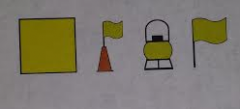
|
Proceed at Work Zone Speed: Speed shall be Work Zone Speed prior to reaching the light or flag. On sight speed not to exceed 10 mph. |
|

|
Proceed: Maintain appropriate speed. If in a work zone resume normal operation when the front of the train reaches the light or flag. |
|

|
DO NOT MOVE CARS: Workers in, under, or about the LRV are protected by this light or flag. |
|

|
Acknowledgement of a stop hand signal |
|

|
Acknowledgement of a proceed or reduce speed hand signal |
|

|
Before making a forward movement |
|

|
Before making a back-up movement, or to acknowledge a back-up hand signal |
|

|
Call for hand signal |
|

|
To be sounded at station platforms |
|

|
To be used at station platforms if the bell signals, R4.21.6 is not sufficient |
|

|
To be used when proceeding through a grade crossing in the yard, work zone, passing workers in the right of way, passing standing trains, and as a warning to people or vehicles on or near the track. |
|

|
To be used when proceeding through a grade crossing in the yard, work zone, passing workers on the right of way, passing standing trains, and as a warning to people or vehicles on or near the track. To be used if bell signals R4.21.8 is not sufficient |
|

|
To be used to indicate the train will be the next train departing Airport Station. To be used one minute prior to departure. |
|

|
When operating on MLK Jr. Way South, ring the bell at least once and no more than three times prior to entering a grade crossing, after which, if no hazard is present, cease ringing the bell. |
|
|
Unnecessary Use of Bell or Horn |
Unnecessary use of the bell or horn is prohibited |
|
|
Bell or Horn Failure |
In case of bell or horn failure, the operator shall notify LCC immediately. If the train is operated with inoperable horn and bell, grade crossing shall be crossed at restricted speed (On sight speed not to exceed 20 mph). |
|
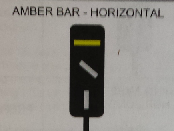
|
Stop |
|

|
PROCEED |
|
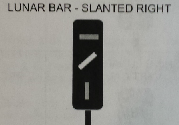
|
PROCEED RIGHT ON DIVERGING ROUTE |
|
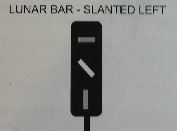
|
PROCEED LEFT ON DIVERGING ROUTE |
|
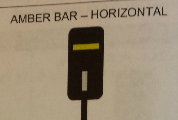
|
Stop |
|
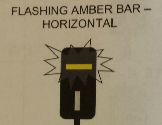
|
STOP PREPARE TO PROCEED |
|

|
PROCEED |
|
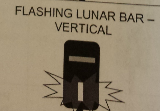
|
PROCEED PREPARE TO STOP |
|
|
Bar Signal Routing Indications |
If a bar signal is providing a proceed indication for anything other than the route authorized per run card, train order/special instruction, or LCC the operator shall stop prior to the bar signal and call LCC |
|
|
Interlocking Signals |
When an interlocking bar signal displaying a proceed indication changes to a stop indication as a train is closely approaching the interlocking, the operator shall immediately bring the train to a stop using Full Service Brake (FSB) application and notify LCC. MXB should not be used unless a hazard is seen. |
|
|
Dark or Malfunctioning Bar Signals |
The first operator encountering a dark or malfunctioning bar signal shall stop prior to the affected bar signal and notify LCC immediately. LCC shall provide instructions to all operators on what action to take at the affected bar signal. .1 - LCC may authorize rail vehicle movement past the bar signal if safe to do so. The operator must ensure it is safe to proceed. |
|
|
Dark or Malfunctioning signals at Non-Gated Grade Crossings |
The first operator encountering a dark or malfunctioning signal at a non-gated grade crossing shall stop at the bar signal prior to the non-gated grade crossing and notify LCC immediately. Upon notification to all trains, and with LCC authorization, operators adhere to the following applicable rules: .1 - When auto traffic signals are dark or displaying a four-way flashing red, operators shall treat the non-gated grade crossing as a four-way stop. The operator shall sound the horn and proceed with parallel auto traffic only when safe to do so. .2 - When the proceed bar signal governing straight-through movements fails to cycle normally, operators shall stop and request the bar signal. If the proceed bar signal fails to appear, the operator shall sound the horn and proceed with parallel auto traffic on a green signal when safe to do so. .3 - When reverse running through a non-gated grade crossing with a dark or malfunctioning bar signal the train shall stop prior to the non-gated grade crossing, sound the horn, and proceed with parallel auto traffic on a green signal when safe to do so. |
|
|
Dark or Malfunctioning Signals at Gated Grade Crossings |
The first operator encountering a gated grade crossing where the gates are operating normally, but the auto traffic signals are dark or displaying a four-way flashing red shall notify LCC and proceed through the grade crossing at restricted speed. Upon notification to all trains, and with LCC authorization, operators will proceed through the gated grade crossing at restricted speed. |
|
|
Signs |
Signs posted on the right of way shall be observed and obeyed. .1 - Any damaged or imperfectly displayed signs shall be reported to LCC immediately |
|
|
Unauthorized Employees |
Unauthorized employees shall not tamper with any sign or component of any signaling system. |

